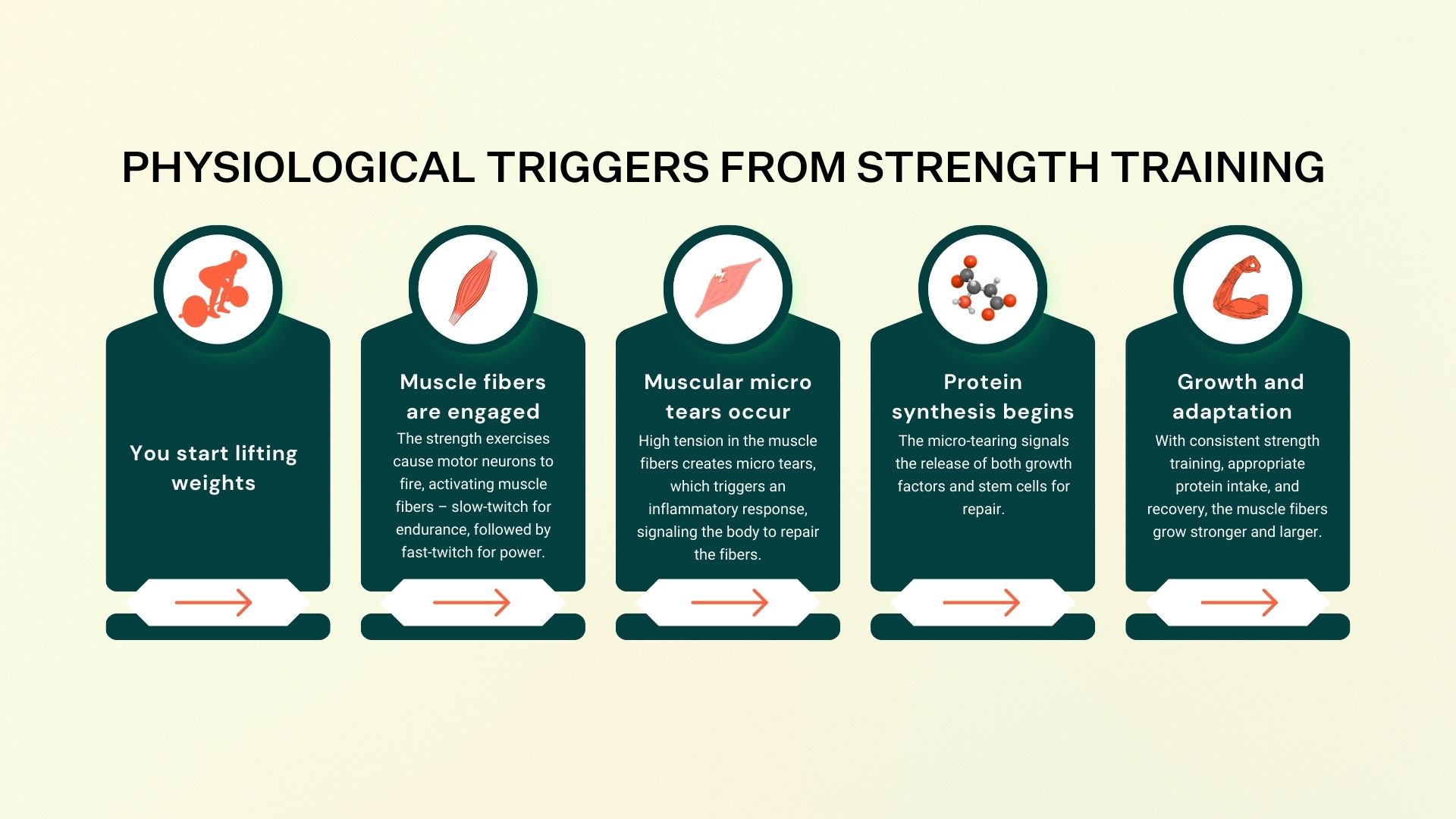Read on and you’ll discover:
- How lifting weights boosts brain health, mood, and mental resilience
- The surprising link between resistance training and heart health
- How lifting helps long-term fat burn and weight management
- How it supports bone density and helps you live a longer, healthier life
- What happens inside your muscles when you lift – and how to get stronger in just six weeks.
Strength training has surged in popularity in recent years. No longer the domain of bodybuilders and athletes, everyday exercisers are embracing lifting weights as a fundamental part of their training. In recent years, it has been declared the most popular fitness genre. Gen Z movers say it's their favorite way to work out, and now 80% of Gen Z gym-goers are focused on getting strong.

If you haven't made strength training part of your weekly workout regime, you’re missing out.
Strength training is good for your mind – and your mood
A 2025 study indicates that lifting weights can be great for your brain health. It’s shown to help improve memory and protect from age-related decline by reducing atrophy in the areas of the brain associated with Alzheimer’s.
And it can also lift your mood. It doesn't matter whether you lift heavy or go light; studies show you'll enjoy mental health benefits regardless. This suggests it's not so much about the muscular adaptations, but the feeling of accomplishment and confidence that goes hand-in-hand with resistance training. There’s also evidence that lifting weights can diminish the effects of anxiety, and we know strength training leads to better posture, which is linked to a better mood.
Strength training goes hand-in-hand with a healthy heart
Aerobic exercise is typically credited as being most beneficial for heart health, but scientists believe strength training could be superior. A recent study compared the cardiovascular risk factors (such as high blood pressure) and exercise habits of 4,000 adults, breaking the exercise into two types: static activities (strength training) and dynamic activities (running). Both types of exercise were associated with lower rates of cardiovascular disease risk, but the static activity appeared to be most beneficial.
The risk of heart attack or stroke was roughly 50 percent lower for those who lifted weights.
According to a group of US researchers, even a small amount of resistance training could lower the risk of heart attack or stroke. These researchers analyzed the exercise habits and medical histories of thousands of men and women across 11 years. They considered how often people engaged in resistance training and the amount of time they dedicated to lifting, assessing it against medical data – specifically incidences of heart attacks, strokes, and deaths. Interestingly, they found the risk of heart attack or stroke was roughly 50 percent lower for those who lifted weights compared to those who didn’t. Those who enjoyed the greatest declines in risk lifted weights twice a week for an hour or so in total. And it seems these savvy strength trainers benefit from the reduced risk even if they don’t engage in frequent aerobic exercise.

Strength training drives long-term fat-burning benefits
Strength training packs more punch than expected when it comes to calorie burn. For a long time, strength training has been mistakenly perceived as being relatively ineffective when it comes to calorie burn. But fascinating research from the Les Mills Lab, published in the Journal of Science and Medicine in Sport, throws that thinking on its head.
A more potent exercise stimulus with a profound effect on long-term fat burn.
The study highlights how, even though strength training typically burns fewer calories than aerobic training, the long-term response is far greater than a calorie-matched cardio workout. Therefore, strength training is a more potent exercise stimulus and has a more profound effect on long-term fat burn.
Discover the truth about strength training and calorie burn.

Strength training creates healthy bones
Good bone density reduces the risk of fractures and osteoporosis and is fundamental to overall good health. But the strength of our bones naturally declines as we age, and from the age of 40, bone mineral density declines at an accelerated rate. Studies show that low-weight, high-repetition resistance training can help mitigate the issue. After working with groups of exercisers over 27 weeks, researchers found those who did regular strength workouts (2-3 times a week) increased bone mineral density in their arms, legs, pelvis and spine. They also saw impressive gains in squat strength, which can be directly correlated to increases in bone mineral density.
Learn more about how to build strong bones.
Strength training can give you a longer and healthier life
Want to live longer? Start lifting. After spending a decade examining data from almost 100,000 adults, academics at the United States National Cancer Institute have concluded that strength training could be the most life-changing form of exercise. They found that people who did some aerobic exercise benefited from a slight drop in mortality risk, but when people combined aerobic and strength training, the benefits were exponential, leading to a 40 percent drop in mortality risk. Research has also shown that those who develop moderate muscle strength are 32 percent less likely to develop diabetes.
Learn more about strength training for a long, healthy life.

Strength training helps you find your healthy weight
Think cardio is the secret to weight loss? Think again. If you want to lose weight and keep it off, strength training is key. Researchers identified that loss of lean muscle tissue during weight loss bumps up the risk of weight regain in the long term.
These findings are particularly important with the rapid rise of GLP-1 medications. While GLP-1’s are an effective way for overweight people to improve their health, most who lose weight with GLP-1’s also lose a significant amount of muscle – one study suggests the muscle loss is on par with 10 years of aging. Those who enjoy the best results from GLP-1 medications do so because they also lift weights.
Learn more about the need for strength when it comes to weight management.
How does lifting weights change your muscles?
As soon as you start lifting weights, it fires up motor neurons and your muscle fibers are activated. Firstly, slow-twitch muscle fibers build endurance and then the fast-twitch muscle fibers drive power. As you lift, the stress your muscles are put under causes microscopic tears in the muscle fibers. In response, protein synthesis begins and your body releases growth factors and stem cells to help repair the muscle fibers. By consistently repeating this process (supported by good protein intake and adequate recovery) your muscle fibers grow stronger.

POPULAR WAYS TO BUILD STRENGTH
BODYPUMP™ is strength endurance and functional conditioning. This full-body workout uses light to moderate weights, high reps and a variety of tempos. You can expect continuous movement and minimal rest, which maximizes time under tension. Find a workout or work out at home.
LES MILLS STRENGTH DEVELOPMENT™ is progressive strength training focusing on three specific training phases – mechanical tension, hypertrophy and integrated strength. Find a workout or work out at home.
BODYPUMP HEAVY™ is tempo-based weightlifting with traditional lifting techniques, slow moves and long recoveries. Find out more.
LES MILLS CORE™ is a scientific core workout for incredible strength, stability and endurance in the muscles that matter most. Find a workout or work out at home.
LES MILLS FUNCTIONAL STRENGTH™ is an innovative hybrid of strength exercises and explosive power moves. Find a workout or work out at home.
LES MILLS GRIT™ Strength fuses high-intensity interval training with barbell, weight plate and bodyweight exercises to spike your heart rate. Find a workout or work out at home.
Learn more about different strength training workouts – and how to choose the best strength workout for your body.
STRENGTH TRAINING OPTIONS EXPLAINED
How strong can you get in six weeks?
Join the six-week Stronger Challenge and get a science-backed training plan developed by Dr Jinger Gottschall.
Watch and learn how to build strength and fitness with just two weight plates.











